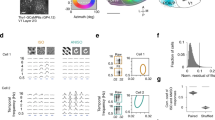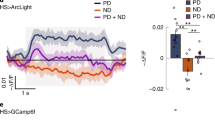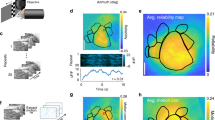Abstract
In many species, neurons responding to visual motion at higher processing stages are often specifically tuned to particular flow fields; however, the neural circuitry that leads to this selectivity is not yet understood. Here we have studied this problem in 'vertical system' (VS) cells of the blowfly lobula plate. These neurons possess distinctive local preferred directions in different parts of their receptive field. Dual recordings from pairs of VS cells show that they are electrically coupled. This coupling is responsible for the elongated horizontal extent of their receptive fields. VS cells with a lateral receptive field have additional connections to a VS cell with a frontal receptive field and to the horizontal system, tuning these cells to rotational flow fields. In summary, the receptive field of these cells consists of two components: one that they receive from local motion detectors on their dendrite, and one that they import from other large-field neurons.
This is a preview of subscription content, access via your institution
Access options
Subscribe to this journal
Receive 12 print issues and online access
$209.00 per year
only $17.42 per issue
Buy this article
- Purchase on Springer Link
- Instant access to full article PDF
Prices may be subject to local taxes which are calculated during checkout





Similar content being viewed by others
References
Lappe, M., Bremmer, F., Pekel, M., Thiele, A. & Hoffmann, K.P. Optic flow processing in monkey STS: a theoretical and experimental approach. J. Neurosci. 16, 6265–6285 (1996).
Tanaka, K. & Saito, H. Analysis of motion of the visual field by direction, expansion/contraction, and rotation cells clustered in the dorsal part of the medial superior temporal area of the macaque monkey. J. Neurophysiol. 62, 626–641 (1989).
Duffy, C.J. & Wurtz, R.H. Sensitivity of MST neurons to optic flow stimuli. I. A continuum of response selectivity to large-field stimuli. J. Neurophysiol. 65, 1329–1345 (1991).
Duffy, C.J. & Wurtz, R.H. Sensitivity of MST neurons to optic flow stimuli. II. Mechanisms of response selectivity revealed by small-field stimuli. J. Neurophysiol. 65, 1346–1359 (1991).
Duffy, C.J. & Wurtz, R.H. Medial superior temporal area neurons respond to speed patterns in optic flow. J. Neurosci. 17, 2839–2851 (1997).
Hoffmann, K.P. & Distler, C. Quantitative analysis of visual receptive fields of neurons in nucleus of the optic tract and dorsal terminal nucleus of the accessory optic tract in macaque monkey. J. Neurophysiol. 62, 416–428 (1989).
Hoffmann, K.P., Bremmer, F., Thiele, A. & Distler, C. Directional asymmetry of neurons in cortical areas MT and MST projecting to the NOT-DTN in macaques. J. Neurophysiol. 87, 2113–2123 (2002).
Crowder, N.A., Lehmann, H., Parent, M.B. & Wylie, D.R. The accessory optic system contributes to the spatio-temporal tuning of motion-sensitive pretectal neurons. J. Neurophysiol. 90, 1140–1151 (2003).
Crowder, N.A., Dawson, M.R. & Wylie, D.R. Temporal frequency and velocity-like tuning in the pigeon accessory optic system. J. Neurophysiol. 90, 1829–1841 (2003).
Gu, Y., Wang, Y. & Wang, S.R. Directional modulation of visual responses of pretectal neurons by accessory optic neurons in pigeons. Neuroscience 104, 153–159 (2001).
Wylie, D.R. & Frost, B.J. Responses of neurons in the nucleus of the basal optic root to translation and rotational flowfields. J. Neurophysiol. 81, 267–276 (1999).
Wang, Y. & Frost, B.J. Time to collision is signaled by neurons in the nucleus rotundus of pigeons. Nature 356, 236–238 (1992).
Hausen, K. Monocular and binocular computation of motion in the lobula plate of the fly. Verh. Dtsch. Zool. Ges. 74, 49–70 (1981).
Hausen, K. The lobula-complex of the fly: structure, function and significance in visual behaviour. In Photoreception and Vision in Invertebrates (ed. Ali, M.A.) 523–559 (Plenum, New York, 1984).
Krapp, H.G. & Hengstenberg, R. Estimation of self-motion by optic flow processing in single visual interneurons. Nature 384, 463–466 (1996).
Krapp, H.G., Hengstenberg, B. & Hengstenberg, R. Dendritic structure and receptive-field organization of optic flow processing interneurons in the fly. J. Neurophysiol. 79, 1902–1917 (1998).
Krapp, H.G., Hengstenberg, R. & Egelhaaf, M. Binocular contributions to optic flow processing in the fly visual system. J. Neurophysiol. 85, 724–734 (2001).
Haag, J. & Borst, A. Recurrent network interactions underlying flow-field selectivity of visual interneurons. J. Neurosci. 21, 5685–5692 (2001).
Haag, J. & Borst, A. Orientation tuning of motion-sensitive neurons shaped by vertical-horizontal network interactions. J. Comp. Physiol. 189, 363–370 (2003).
Borst, A. & Haag, J. Neural networks in the cockpit of the fly. J. Comp. Physiol. 188, 419–437 (2002).
Strausfeld, N.J. Functional neuroanatomy of the blowfly's visual system. In Photoreception and Vision in Invertebrates (ed. Ali, M.A.) 483–522 (Plenum, New York, 1984).
Bausenwein, B., Dittrich, A.P. & Fischbach, K.F. The optic lobe of Drosophila melanogaster. II. Sorting of retinotopic pathways in the medulla. Cell Tissue Res. 267, 17–28 (1992).
Buchner, E. & Buchner, S. Mapping stimulus-induced nervous activity in small brains by [H]2-deoxy-D-glucose. Cell Tissue Res. 211, 51–64 (1980).
Single, S. & Borst, A. Dendritic integration and its role in computing image velocity. Science 281, 1848–1850 (1998).
Haag, J., Theunissen, F. & Borst, A. The intrinsic electrophysiological characteristics of fly lobula plate tangential cells. II. Active membrane properties. J. Comput. Neurosci. 4, 349–369 (1997).
Hausen, K. Motion sensitive interneurons in the optomotor system of the fly. II. The horizontal cells: receptive field organization and response characteristics. Biol. Cybern. 46, 67–79 (1982).
Hengstenberg, R., Hausen, K. & Hengstenberg, B. The number and structure of giant vertical cells (VS) in the lobula plate of the blowfly Calliphora erytrocephala. J. Comp. Physiol. A 149, 163–177 (1982).
Haag, J. & Borst, A. Amplification of high-frequency synaptic inputs by active dendritic membrane processes. Nature 379, 639–641 (1996).
Schmitz, D. et al. Axo-axonal coupling: a novel mechanism for ultrafast neuronal communication. Neuron 31, 831–840 (2001).
Mamiya, A., Manor, Y. & Nadim, F. Short-term dynamics of a mixed chemical and electrical synapse in a rhythmic network. J. Neurosci. 23, 9557–9564 (2003).
Farrow, K., Haag, J. & Borst, A. Input organization of multifunctional motion sensitive neurons in the blowfly. J. Neurosci. 23, 9805–9811 (2003).
Kimpo, R.R., Theunissen, F.E. & Doupe, A.J. Propagation of correlated activity through multiple stages of a neural circuit. J. Neurosci. 23, 5750–5761 (2003).
Denk, W., Strickler, J.H. & Webb, W.W. Two-photon laser scanning fluorescence microscopy. Science 248, 73–76 (1990).
Borst, A., Denk, W. & Haag, J. In vivo calcium imaging in the fly visual system. in: Imaging Living Cells: A Laboratory Manual 2nd edn (eds. Yuste, R., Lanni, F. & Konnerth, A.) Ch. 44 (CSHL, Cold Spring Harbor, NY, 2004).
Acknowledgements
We are grateful to R. Gleich for excellent technical assistance. This work was supported by the Max-Planck-Society.
Author information
Authors and Affiliations
Corresponding author
Ethics declarations
Competing interests
The authors declare no competing financial interests.
Supplementary information
Supplementary Fig. 1
Possible wiring scheme for the VS7/8-cell. (a) Schematic drawing of the receptive field of VS7/8. It shows three features: I a broad vertical sensitivity for downward motion, II an upward sensitivity in the frontal part of the receptive field and III a horizontal sensitivity in the dorsal visual field. (b) Underlying network: VS7/8 is connected to its neighboring VS-cell (VS6 and VS9) through electrical synapses, resulting in a broad vertical sensitivity for downward motion (I). It receives inhibitory input from VS1 which itself is excited by downward motion in the frontal visual field. This causes the upward sensitivity found in VS7/8 (II). In addition VS7/8 is electrically coupled to a spiking neuron (X) that is responsible for the EPSPs measured in VS7/8. The spiking neuron receives excitatory input from HSN. This connection results in the horizontal sensitivity of VS7/8 in the dorsal part of the receptive field (III). (JPG 17 kb)
Rights and permissions
About this article
Cite this article
Haag, J., Borst, A. Neural mechanism underlying complex receptive field properties of motion-sensitive interneurons. Nat Neurosci 7, 628–634 (2004). https://doi.org/10.1038/nn1245
Received:
Accepted:
Published:
Issue Date:
DOI: https://doi.org/10.1038/nn1245
This article is cited by
-
Neuroanatomy and functional morphology of peripheral receptor neurones with direct projections into the protocerebrum of the brains of the locust and a jewel beetle
Zoomorphology (2023)
-
Non-uniform weighting of local motion inputs underlies dendritic computation in the fly visual system
Scientific Reports (2018)
-
A Heuristic Framework of Spatial Ability: a Review and Synthesis of Spatial Factor Literature to Support its Translation into STEM Education
Educational Psychology Review (2018)
-
Complementary motion tuning in frontal nerve motor neurons of the blowfly
Journal of Comparative Physiology A (2015)
-
Subcellular mapping of dendritic activity in optic flow processing neurons
Journal of Comparative Physiology A (2014)



